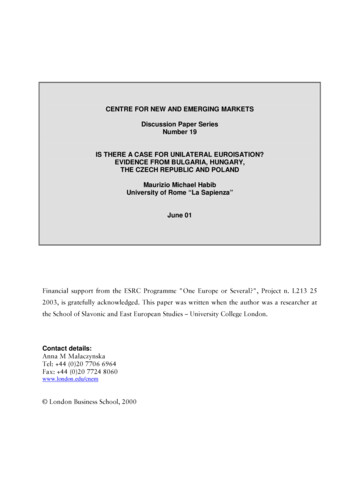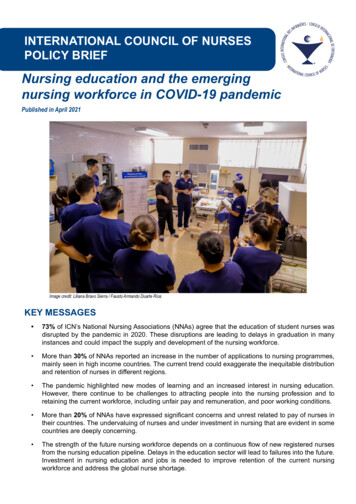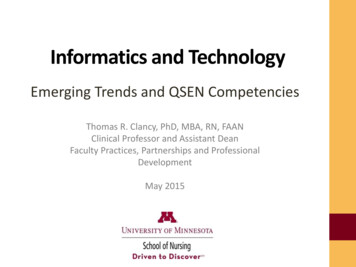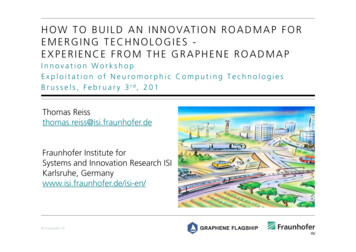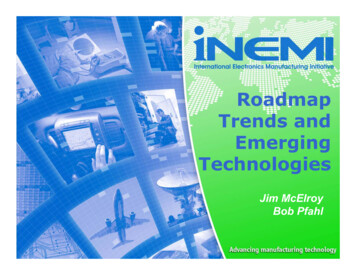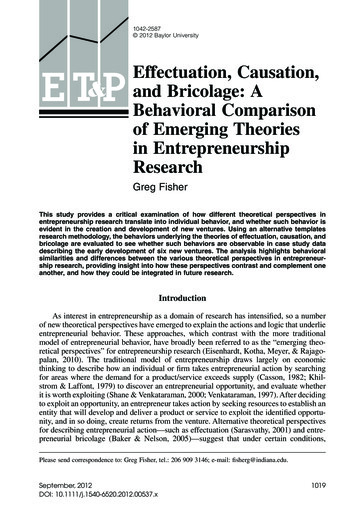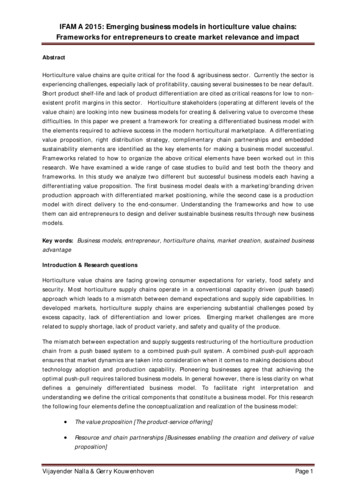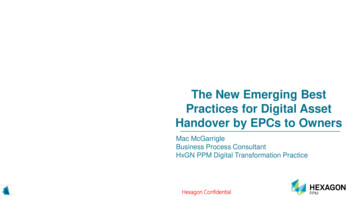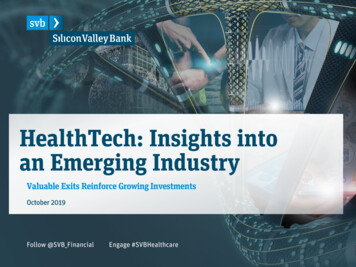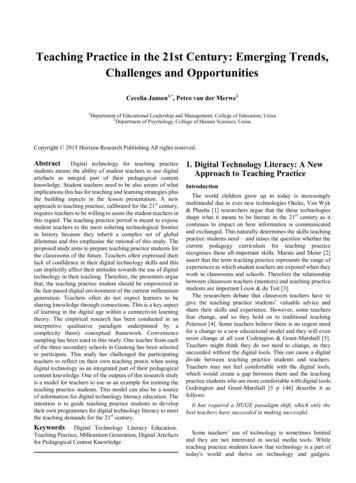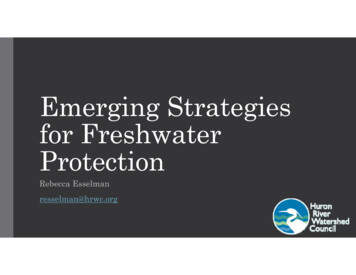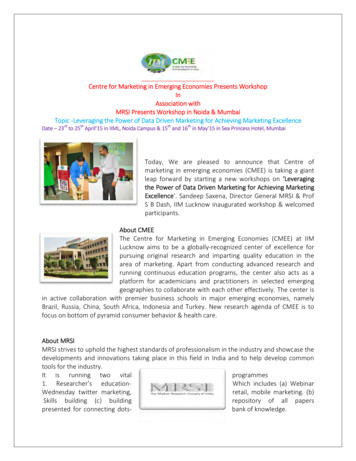
Transcription
Centre for Marketing in Emerging Economies Presents WorkshopInAssociation withMRSI Presents Workshop in Noida & MumbaiTopic ‐Leveraging the Power of Data Driven Marketing for Achieving Marketing ExcellenceDate – 23rd to 25th April’15 in IIML, Noida Campus & 15th and 16th in May’15 in Sea Princess Hotel, MumbaiToday, We are pleased to announce that Centre ofmarketing in emerging economies (CMEE) is taking a giantleap forward by starting a new workshops on ‘Leveragingthe Power of Data Driven Marketing for Achieving MarketingExcellence’. Sandeep Saxena, Director General MRSI & ProfS B Dash, IIM Lucknow inaugurated workshop & welcomedparticipants.About CMEEThe Centre for Marketing in Emerging Economies (CMEE) at IIMLucknow aims to be a globally‐recognized center of excellence forpursuing original research and imparting quality education in thearea of marketing. Apart from conducting advanced research andrunning continuous education programs, the center also acts as aplatform for academicians and practitioners in selected emerginggeographies to collaborate with each other effectively. The center isin active collaboration with premier business schools in major emerging economies, namelyBrazil, Russia, China, South Africa, Indonesia and Turkey. New research agenda of CMEE is tofocus on bottom of pyramid consumer behavior & health care.About MRSIMRSI strives to uphold the highest standards of professionalism in the industry and showcase thedevelopments and innovations taking place in this field in India and to help develop commontools for the industry.It is running two vitalprogrammes1. Researcher’s education‐Which includes (a) Webinarretail, mobile marketing. (b)Wednesday twitter marketing,Skills building (c) buildingrepository of all paperspresented for connecting dots‐bank of knowledge.
2. Quality data generation which includes showing interview tech, recording interview videos1st session ‐ Prof S B DashEmerging Trends that favor Data DrivenMarketingThis session started with tools & techniquesused by marketing practitioners, to getconsumer insights since 2001. Forces behinddata driven marketing is economics ofconsumers & budgeting, advancing technologydue to marketing automation, optimization &growing business analytics. Intensifyingcompetition is making it imperative forcompanies to get into data driven marketing.Prof explained benefits of data drivenmarketing by using one recent survey. Keyemerging trends in Data driven marketing are1. Marketing and Sales Co‐own the Revenue production2. First Touch, Last Touch and Everything In Between now Matter.3. Big Data is Becoming Bigger in Marketing.4 The Emergence of the Marketing Technologist Will Come to Full Glory5. Marketing is taking Big Steps toward Customer IntelligenceProfessor also used one marketing software to make participant familiar with recentdevelopment in data analytics & to explain, how they can use it to get richer information?Conjoint analysis, factor analysis, cluster analysis & preference mapping discussed with theparticipants with the help of case studies.2nd session ‐ Mr Titir PalCurrent practices in bigdata analyticsBig data analyticsevolved to cater to changeddataenvironment.Companies are doing samething even today i.e.creating & communicatingvalue, But the changein variety, volume & velocityof data has changed themathematics of attractingnew customers & retaining older one. More data does not mean you have new problem, itmeans you have more insights of consumer. Which can be used to design new products,preparing communication content & provide quick service recoveries.
Big data analytics is a movement from Causation to correlation. Fallowing four cases are exampleof clever data analytics to get operational efficiency, new revenue modes etc.Case1Hotel loyalty programmer‐decision engineering in hotel industry to make travels more holisticCase2FMCG retail‐ Retailer’s segmentation to make supply chain more organicCase 3 ‐Telecom‐ maximizing potential of geospatial data & monetizing this data i.e. How to suggestwhere to set up store?Case 4 ‐Mining machine‐ internet of things (geospatial data for traffic management) ‐predictivemaintenance of trucks saved huge maintenance cost.Session 3Mr Vinit GoenkaListening consumers through social networkListening is a skill that we can all benefit from improving. By becoming a better listener, you willimprove your productivity, as well as your ability to influence, persuade and negotiate. What'smore, you'll avoid conflict and misunderstandings. All of theseare necessary for workplace success!BJP listened to theconsumers during elections & used those insights to plan theirpolitical campaigns. BJP also segmented whole India into 144segments based in gender, age, income, social media usageetc.Session 4Mr Arun V. ChearieBig Data & Big Data Analytics in Customer ValueManagement: Strategies and ExecutionAnalytics is extracting information from data. Big data islarge variety of data accumulating with great velocity.Among new industries, automobile companies are usingsensors in cars to gather data of drivers i.e. driving style,speed etc.For big data two things are important
1. Analytics2. Deriving information from dataIn big data world essentially the way of reporting has been changed, now it’ more than simplereporting. Ethnographic studies are now taking place inside houses to get instant data,ethnographer is now watching actual data more closely. A new age of real‐time insight drivencustomer centric decisioning in marketing is coming out. Retargeting is new phenomena whereonline companies track a customer purchase for the products, it does not have. Retail stores areusing sensors to track buyer’s eye movement, product search.The four p of marketing are gradually being retired & few new A’s are taking place i.e. anytime,anyplace etc.Session 5Prof Moutusy MaityGaining Consumer Insights through Social Network AnalysisEverything is connected: people, information, events and places, all the more so with the adventof online social media. A practical way of making sense of the tangle of connections is to analyzethem as networks.SNA provides both avisual and a mathematical analysisof human relationships.To understand networks and theirparticipants,weevaluate the location of actors inthe network. Measuringthe network location is findingthe centrality of a node.These measures give us insight intothe various roles and groupings in a network ‐‐ who are the connectors, mavens, leaders,bridges, isolates, where are the clusters and who is in them, who is in the core of the network,and who is on the periphery.SNA provides important strategic information. Seed marketing can be more effective by usingSNA.Session 6 ‐Dr Ranjit NairCompeting in the Age of the Customers: Social Media Intelligenceto the RescueLarge bundle of social media tools are available. To know whichtool is to use is very important. Social media intelligence in actionis possible with listening, engaging & measuring. Now real timedata tracking is possible. Through sentiment analysis, one canunderstand the real mood of customer. Historical information
tracking & decoding market trends are also possible.MTV Coke studio when it failed to garner good TRPs, It took help of social media analytics toolsto get insight episode by episode. Integrating data driven analytics helped Coke studio toimprove its content & quality.Day2 ‐Session1 ‐Prof. S. VenkatReal Time Consumers and SupplyChain AnalyticsAkshya Patra brought thebest thinking inmanufacturing, supply chain,innovation andlogisticscreate a centralmanagementtokitchen model whereby food iscentrally cookedand delivered by truck to local schools. In addition, it also constantly innovates – including usingdata analytics, cooking using clean energies and constantly improving ingredients to havehealthier food – while keeping the cost the same. The goal for the Supply chain analyticscategory is to link together all the different statistical, mathematical and optimization methodsthat would be beneficial to any supply chain professional. Similarly, Forecasting can be used insupply chain management to ensure that the right product is at the right place at the right time.Accurate forecasting will help retailers reduce excess inventory and thus increase profit marginSESSION 2 ‐Mr Himanshu ChopraUses of Data to mitigate fraudulent activities and maintain health of online platformDigital India is the new anthem. In2015,Internetpenetration in India is 16% &smartphonepenetration is 20%, It showsemerging potential inonline domain. Analytics valuechaindescription of what happened,diagnosis, prediction& finally prescription. Analyticscombined with digitalstartsfromsurveillance is new tool for price discrimination over online platform.E‐commerce is facing various types of risks i.e. payment frauds, high product return, B2B transaction,damaged product, empty parcel etc. To mitigate risk, e‐commerce players have taken several measureslike seller rating (based on delayed delivery, empty parcel, damaged product, package lost). Sellers rating
has solved 20‐30 % problems. Seller evaluation on multiple parameter i.e. complaint HOSTORY, SALESdata, subjectivity in raising complain decides their future commercial relations with the e‐commercecompaniesSession 3Banking on Analytics‐ Mr Anup Kumar SinhaMiddle class is growing rapidly & willing to do thingsdifferently. Appropriate provisioning of technology purchase isneed of the hour. Definition of data is also changing now. TheBanking anytime anywhere resulted into near real timeconvergence of channel, single view of customs (means 360degree information), mobility: banking on the move. Some Newtechnology trends like Network connectivity, NFC, RFID, beacons, big data & in memory, machine datahas changed the banking services delivery. In coming future, Physical papers work needs to go away. GPSbased Geocoding i.e. coded pin codes will strategies future course of actions like, Determine growthpotential of new branch location, gauge market share, identifying sources of lagging & priorities growthpotential. Analytics integration with banking domain requires domain expert, analytics expertise,technology expertise. Heat maps are also now used frequently by bankersSession 4‐Mr Pratul ChandraChanging Paradigm in Analytics and how SAP Analyticsaddresses the sameAnalytical needs and the consequences in IT architecture isnow visible in tangible form. High variety if informationcoming at great speed. Different approach & tools arerequired to utilize its potential.Real time data platform integration & real time analytics willprovide the competitive edge. An entity, which is willing to make break into analytics should1.Democratize predictive analytics‐ productive predictive solution for all. 2. Real‐time predictive analyticsfor big data‐anticipate risks & opportunities in real time 3. Embed predictive analytics‐ incorporate Sap
predictive analytics tool 4.incorporate predictive results into business processes. Sap HANA will addressabove issues.Day 3 ‐ Prof Bharat BhaskarRecommendation system & collaborative filteringPeople leave trails during net surfing, onlinedomain players use cues to reduce cognitive effortof people & generate more sales .Online surfingprovide inputs in click through phase, basketplacement phase & basket to purchase phase.Among two product categories different tools areused to generate consumer insights. For example1. LIP (do‐feel‐think) collaborative filtering data mining2. HIP (think‐fee‐do) automobile recommender different set of tools used by companiesRank of a web page depends on the rank of the webpages pointing to it, companies are usingabove insights to improve their page rank. Content filtering is also one of the tools to filtercontent & get more specific insights. Retail stores are using Association rule mining to sale moreproduct & making shopping experience more convenientTS Mohan Krishan ‐ Using Big‐ness dataUsing operational data with GIS map secondary dataA GIS cannot function without data, and that generally themore data there is then the greater versatility that a GISwill have and the greater will be the potential functionalityof any GIS. With regard to the usage of GIS generally, thesituation has now been arrived at whereby considerationsof data are more important than issues concerninghardware or software. GIS related data can be used
Use case 1: basic analytical toolsSales data can be dynamically managed to locate shop and plan routs to reach target groups. Italso enable predictive model to see demand & sales.Use Case 2: Mobile sales long hours is negatively correlated to sales effectiveness, women makebetter sales person, significant improvement in productivity by sifting sales man closer to theirhome area.Rural opportunity is even bigger‐ Bt cotton companies concerned of farmers suicide so they sellGM cotton seed to farmers who have soil depth data , not primarily rain fed area & they are alsoEmpowering decision makers to gain important insight.Session 3Mr Deepak Goel – CEO & Mr Manas Kar –Practice Lead Analytical Engines Drizzlin AND juxt‐Uses and Application of Social Media Information for Strategic Marketing DecisionAvailability of vast quantities of social‐media data points has spawned an array of new analyticmethods that can structure and derive insight from complex information. Social intelligence willsharpenstrategicinsights, and leaders must beimmersed in the newinformation currents. Fewsocial intelligence toolsare‐Social media platformTwitterMeasure and boostuser impact on Twitter.Data aggregators doanalyticstoolData aggregation, which isa type of data and information mining process where data is searched, gathered and presented.Twitter streaming API, ‐ The Streaming APIs give developers low latency access to Twitter's globalstream of Tweet data. Sentiment analysis library is available‐ create your library & classifiers.Session 4‐Mr Shailesh Kumar
From Data to Decisions: Completing the Analytic CycleGoogle wants to create intelligent machine.Intelligence is ability to generalize. Fromdata to decision, data‐insights‐features‐domain knowledgeDate your data‐ Your data needs willdepend very much on your offering but it’simportant to identify what informationyou can easily obtain and use. That’s the key here. Before you go on a mass data collectioncampaign, decide what you need and more importantly what you can use to make yourcommunications more targeted before. The key is to start small and go back to the data’s roots:the customer. After all it’s about them, you’re doing it for them so it’s important you get to knoweach individual customer first before we attempt to build our data monopolies.Session 5 – Dr Lipika DeyMining Consumers Generated Text for MarketingInsightsProsumer is new phenomena, consumer are nowco‐producing with companies. . Consumerthoughts, beliefs, wishes, experiences,interactions are important to understand new trends. Consumer footprints analysis can improvebrand image, increase retention, helps in new product development & get competitorintelligence.Sentiment viz‐ Recent tweets that contain your keyword are pulled from Twitter and visualized inthe Sentiment tab as circlesSocial media monitoring has become a primary form of business intelligence, used to identify,predict, and respond to consumer behavior. Listening to what your customers, competitors,critics, and supporters are saying about you is key to getting great results from your social media
campaigns. There are countless tools out there, offering many ways to analyze, measure, display,and create reports about your engagement efforts.Gather own your data through dedicated crawlers/ use site‐provided API. Clean it then Store &Process data using NLP toolkit, Tokenize‐break into words & finally use data analytics toolsProf BK MohantyUnderstanding Consumers Search Behavior e‐ commerce platform in Fuzzy Environment Latentconnectivity in human decision makingIn any business, particularly through theInternet, a customer normally develops inhis/her mind some sort of ambiguity, giventhe choice of similar alternative products.The ambiguity is mainly due to tworeasons. Firstly, how to make a finalproductchoicetopurchase,and,secondly, on what basis the otherproducts will be rejected. In order to answer the above questions, the customer may like toclassify the products in different preference levels, preferably through some numerical strengthof preference.Based on the customer's fuzzy choice of the product attributes, products are classified intohierarchical preference levels. This classification is an aid to the customer in making a final choiceof the product. Thus, a buyer can select a product being fully aware of the hierarchicalpreference order. The hierarchical product classification acts as a decision aid to the customer, inthe sense that the customer himself/herself will come to know the information about wherehis/her chosen product stands in the product profile. This will also help him/her to upgradehis/her product choice to a different level should the situation so demands.
Prof. Rajiv Srivastava‐ Director,IIML, Noida Campus.He thanked all for creating sucha wonderful and successfulworkshop! He assured CMEEwill be conducting these kind ofworkshops in future too enefitted to a great extent.are
companies to get into data driven marketing. Prof explained benefits of data driven marketing by using one recent survey. Key emerging trends in Data driven marketing are 1. Marketing and Sales Co‐own the Revenue production 2. First Touch, Last Touch and Everything In Between now Matter. 3.
